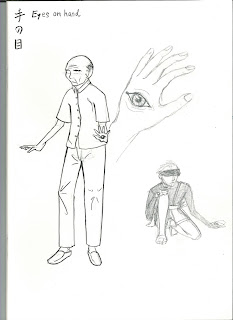 |
| proposals in 2 different idea |
This week I showed tutor my amended proposal ( just took out those academic stuff and specified what I am going to do) and bit of drawing I've done. My idea was to create a book which content a series of character concept art and I was suggested to have sequence or connection between those images, to give the book a rationale. However my approach to this concept art are quite independent, which according to tutor, they don't necessary come in a book, maybe I could think of other way of presentation. My tutor also reminded me not to worry to much about the presentation as context development is more important now.
At this stage, I just tried to re-develop Toriyama Sekien's illustration, trying to link it with any other context, either in local or foreign culture, or other kind of practice. I have picked 3 demons to work with so far, which each of them have a very different function based on the description.
Shivers, 震々Buruburu
Sekien's related Buruburu with the God of Cowardice, used to explain the act of fear (shiver). "Coward" was illustrated in the form of ghost, which believed is the biggest fear of people (even now), indicated abstract existence for the feeling. I related it with Dementors, starring in Harry Potter, described as dark, exile, foul, creature that took away human soul. The function and description are nearly the same for both demons, even the visualise Dementors in Harry Potter film also have similarity in element.
 |
| screen shot of Dementors in Harry Potter film |
 |
| screenshot of Dementors in Harry Potter film |
 |
| Buruburu in Sekien's catalog |
 |
| My illustration of Buruburu |
Eyes on hand, 手の目 Tenome
Originally described as an giant old man with eyes on hand, from The Story of the Man who Gave a Bone to a Monster (化け物に骨をぬかれし人の事). Tenome may intent to illustrate disability of the elderly, touch to discover things around due to weak sights, or like a blind.
 |
| Tenome in Sekien's catalog |

Red Tounge, 赤舌 Akashita
This might be a creation from the folkltale which explain the natural disaster-- flood. It is known by the broken dam at the bottom of Sekien's illustration. Akashita remind me of the Chinese myth-- dragon, which it is believed to control weather. Dragon dance is a kind of ritual to pray for good weather all year round. Dragon dance has became one of an essential activity or performance during Chinese New Year.
 |
| Akashita in Sekien's catalog |
Reference:
Papp, Z. (2010). Anime and its roots in early japanese monster art (1st ed.). Folkestone: Global Oriental.



No comments:
Post a Comment